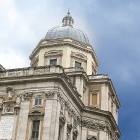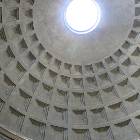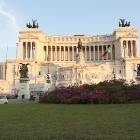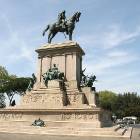
When people hear “the cathedral of Rome” usually think of St Peter’s Basilica in the Vatican, from where the Pope delivers the Easter benediction. Well, in fact St Peter’s is not a cathedral at all, it’s a “regular” church, despite its architectural and historical value. The term cathedral comes from the Latin word for seat, […]

Palazzo Braschi was built in the 18 century by the duke Luigi Braschi Onesti. Under the Napoleonic occupation of Rome, duke Braschi was declared mayor of the city. Donated to the Italian state, the palace was used by Benito Mussolini as his headquarters. The most important architectural piece of the palace is the monumental marble […]

The Pantheon was a pagan temple dedicated to all gods, commissioned by Marcus Agrippa. It was meant to impress by its unprecedented dimensions and shape and was heavily decorated, in contrast with the austere interior we see now. It was probably very colorful, with stars painted on the ceiling, statues in every niche and golden […]

The forum was the most important public place in ancient Rome, an open space surrounded by columns and statues of revered historic figures, in which the local elite could meet to discuss politics, raise popular support, take part in elections and make commerce. Temples and political institutions surrounded the forum. A term somewhat misleading for […]

The majestic monument of reunification is at the end of one of the most important boulevard, Via del Corso, close to the Roman Forum, the Colosseum, Capitoline and Palatine Hill, the most important historic hill of ancient Rome. Thousands of years of history surround us here and this impressive masterpiece rises up to the task […]

Garibaldi is the most celebrated Italian historic figure, with monuments, streets and public squares in almost every city of the country. Giuseppe Garibaldi is the artisan of Italy’s unification in today’s borders, or the Risorgimento, as the process was known. The reunification started in the aftermath of the defeat of Napoleon. The reactionary monarchs of […]

Inside the green gardens of Villa Borghese, very close to the zoo garden, the The Zoology Museum in Rome (Museo Civico din Zoologia) presents animals from a scientific point of view. The animals preserved in the museum help scholars and scientists to understand the species they represent and their habitat. An impressive number of 5 […]

The conquest of Dacia by the Romans was such an important event for the empire, that Trajan payed for a nonstop party of 123 days at the Colosseum. Following the Latin motto “bread and circus”, the show was on a grandiose scale: 10.000 gladiators fought 11.000 wild animals during it. To put it in today’s […]

For some, Napoleon is one of the most brilliant men that ever lived, a legislator that was ahead of his time and an audacious conquerer. For others, the Corsican was just a ruthless tyrant, whose obsession with war and power has cost the lives of 6 millions. Not only the French honor Bonaparte. A museum […]

Along with Piazza di Spagna, the Colosseum, the Vatican or Victor Emmanuel Palace, Fontana di Trevi is a major tourist attraction that is not to be missed when in the eternal city of Rome. The name of Fontana di Trevi does not come from a specific character as one might think, but from two Italian […]

The Biopark, or the Zoo Garden, is a fraction of the vast park called Villa Borghese, the second largest green area o Rome. The zoo garden was established a century ago and a decade ago was reinvented as a natural reservation with as little fences as securely possible. By a clever system of ditches and […]
- Home Page
start page - Architecture
landmark buildings - Sacred architecture
places of worship - Nature
landscape photography - Concert
performing artists - Christmas
Santa Claus pictures
- Jooble
jobs for photographers - Escape
an out of control blog - Merry Christmas
The best organizer of Christmas parties - Astro photo
Eclipse hunting and astrological photography

